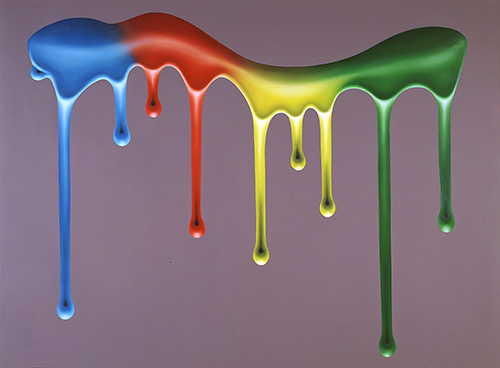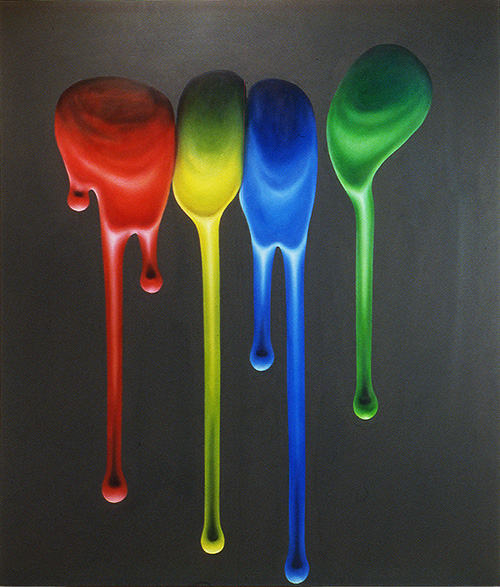Robert Sill, curator at the Illinois State Museum (Exhibition: "Out of the shadow of Ivan Albright, Illinois Art Gallery, 1997")
DRIPS
(Chicago 1996-99)
Ich erforsche seit einiger Zeit in meiner Arbeit die Grundgegebenheiten, die ein Tafelbild formal und historisch in Bezug auf die klassische thematische Unterteilung des Mediums definieren.
 Während ich in meinen Bildbildern der letzten Jahre das Bild als Objekt und Körper, beschränkt durch seine Form und dessen Architektur thematisiert hatte, ging ich mit der neuen Serie von einem der Grundmaterialen der Malerei, nämlich der Farbe in der Konsistenz, wie ich sie als Maler verwende, aus.
Während ich in meinen Bildbildern der letzten Jahre das Bild als Objekt und Körper, beschränkt durch seine Form und dessen Architektur thematisiert hatte, ging ich mit der neuen Serie von einem der Grundmaterialen der Malerei, nämlich der Farbe in der Konsistenz, wie ich sie als Maler verwende, aus.
Hierbei interessierte mich ihr flüssiger Rohzustand während des Malprozesses und der Nachvollzug der Aktion während des Entstehens. Meine derzeitige Arbeit ist eine Parodie der heroisch-männlichen Geste des Tropfens und Sich–Ergießens, die normalerweise mit dem abstrakten Expressionismus in Zusammenhang gebracht wird.
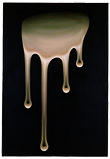 Mich interessiert daran die Ikonographie,der personalisierte Strich des Künstlers, der das Produkt von Zufall und Aktion, begrenzt nur vom Feld der Leinwand ist. Im Gegensatz dazu male ich auf eine genaue und kontrollierte Weise in ausgesuchten Farben Tropfen, die ansonsten aus Missgeschicken herrühren. Diese Tropfen sind unheimliche Spuren des menschlichen Körpers wie zum Beispiel die Flecken auf Möbeln und Teppichen, die ich in gemieteten Wohnungen oder Hotels vorgefunden habe, wenn ich auf Reisen war.
Mich interessiert daran die Ikonographie,der personalisierte Strich des Künstlers, der das Produkt von Zufall und Aktion, begrenzt nur vom Feld der Leinwand ist. Im Gegensatz dazu male ich auf eine genaue und kontrollierte Weise in ausgesuchten Farben Tropfen, die ansonsten aus Missgeschicken herrühren. Diese Tropfen sind unheimliche Spuren des menschlichen Körpers wie zum Beispiel die Flecken auf Möbeln und Teppichen, die ich in gemieteten Wohnungen oder Hotels vorgefunden habe, wenn ich auf Reisen war.
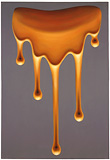 Als großformatige Tafelbilder entwickelt werden die Tropfen in Relation zur menschlichen Körpergröße gesetzt, um eine Rückbindung der ”verkörperlichten” Farbe an den Körper des Erzeugers/Betrachters zu erreichen. Ausserdem wird durch diese Vergrösserung und die Verwendung von klassischem Malmaterial das Beiläufige und negativ Konnotierte von unabsichtlich hervorgerufenen Flecken zur Absurdität.
Als großformatige Tafelbilder entwickelt werden die Tropfen in Relation zur menschlichen Körpergröße gesetzt, um eine Rückbindung der ”verkörperlichten” Farbe an den Körper des Erzeugers/Betrachters zu erreichen. Ausserdem wird durch diese Vergrösserung und die Verwendung von klassischem Malmaterial das Beiläufige und negativ Konnotierte von unabsichtlich hervorgerufenen Flecken zur Absurdität.
For some time, I have been investigating through my work the basic conditions which define painting formally and historically regarding the distinctive classical disciplines of the medium.
 In my “Picture pictures” of the last years I brought up for discussion the picture as object and body, limited by its form and its architecture. This time, in my new series I started over using color as the topic – color being another basic component in painting, namely in its consistency, in the way I use it as a painter. In this context I am alsoaware ofits liquid raw state duringthe paintingprocess and how it develops through the painting process. My current work is a parody of the heroic male gesture of dripping and gushing that is closely identified with abstract expressionism.
In my “Picture pictures” of the last years I brought up for discussion the picture as object and body, limited by its form and its architecture. This time, in my new series I started over using color as the topic – color being another basic component in painting, namely in its consistency, in the way I use it as a painter. In this context I am alsoaware ofits liquid raw state duringthe paintingprocess and how it develops through the painting process. My current work is a parody of the heroic male gesture of dripping and gushing that is closely identified with abstract expressionism.
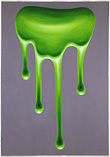 I am concerned with the recognizable iconography, the “personalized stroke”, of the artist that is the product of chance and wild rapturous action defined by the field of the canvas. On the contrary, I make paintings of drips with carefully selected colors in a precise and fully controlled manner that are ordinarily the results of accidents. These drips are the uncanny traces of human body and experience such as drips on furniture that I have found in furnished places, hotels or studios where I have stayed while traveling.
I am concerned with the recognizable iconography, the “personalized stroke”, of the artist that is the product of chance and wild rapturous action defined by the field of the canvas. On the contrary, I make paintings of drips with carefully selected colors in a precise and fully controlled manner that are ordinarily the results of accidents. These drips are the uncanny traces of human body and experience such as drips on furniture that I have found in furnished places, hotels or studios where I have stayed while traveling.
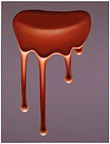 The drips are developed in large-scale paintings in order to set them in relation to the size of the human body and link the embodied color to the body of the producer/viewer. The casual and negative connotation of unintentionally caused stains (drips) becomes absurd by being enlarged and rendered in a classical manner. Simultaneously, the drip, standing for abstraction, becomes the object of representation.
The drips are developed in large-scale paintings in order to set them in relation to the size of the human body and link the embodied color to the body of the producer/viewer. The casual and negative connotation of unintentionally caused stains (drips) becomes absurd by being enlarged and rendered in a classical manner. Simultaneously, the drip, standing for abstraction, becomes the object of representation.
